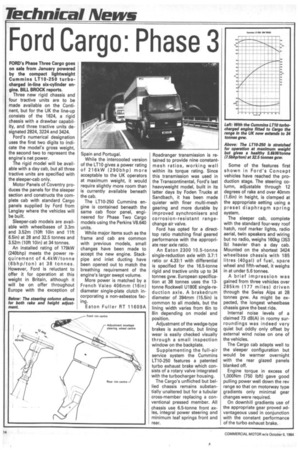Ford Cargo: Phase 3
Page 18

If you've noticed an error in this article please click here to report it so we can fix it.
FORD's Phase Three Cargo goes on sale from January powered by the compact lightweight Cummins LT10-250 turbocharged in-line six-cylinder engine. BILL BROCK reports.
Three new rigid chassis and four tractive units are to be made available on the Continent, but for the UK the line-up consists of the 1624, a rigid chassis with a drawbar capability, and three tractive units designated 2824, 3224 and 3424.
Ford's numerical designation uses the first two digits to indicate the model's gross weight, the second two to represent the engine's net power.
The rigid model will be available with a day cab, but all three tractive units are specified with the sleeper-cab only.
Motor Panels of Coventry produces the panels for the sleeper section and constructs the complete cab with standard Cargo panels supplied by Ford from Langley where the vehicles will be built.
Sleeper-cab models are available with wheelbases of 3.3m and 3.52m (10ft 10in and lift 6.5in) at 28 and 32.5 tonnes and 3.52m (10ft 10in) at 34 tonnes.
An installed rating of 179kW (240bhp) meets the power requirement of 4.4kW/tonne (6bhp/ton) at 38 tonnes. However, Ford is reluctant to offer it for operation at this weight in Britain, although it will be on offer throughout Europe with the exception of Spain and Portugal.
While the intercooled version of the LT10 gives a power rating of 216kW (290bhp) more acceptable to the UK operators at maximum weight, it would require slightly more room than is currently available beneath the cab.
The LT10-250 Cummins engine is contained beneath the same cab floor panel, engineered for Phase Two Cargo models using the Perkins V8.640 units.
While major items such as the frame and cab are common with previous models, small changes have been made to accept the new engine. Stackpipe and inlet ducting have been opened out to match the breathing requirement of the engine's larger swept volume.
More power is matched by a French Valeo 406mm (16in) diameter single-plate clutch incorporating a non-asbestos facing.
Eaton Fuller AT 11609A Roadranger transmission is retained to provide nine constantmesh ratios, working well within its torque rating. Since this transmission was used in the Transcontinental, Ford's last heavyweight model, built in its latter days by Foden Trucks at Sandbach, it has been made quieter with finer multi-mesh gearing and more durable by improved synchronisers and corrosion-resistant rangechange air valve.
Ford has opted for a directtop ratio matching final geared performance with the appropriate rear axle ratio.
An Eaton 2300 10.5-tonne single-reduction axle with 3.7:1 ratio or 4.33:1 with differential is specified for the 16.5-tonne rigid and tractive units up to 34 tonnes gvw. European specification at 38 tonnes uses the 13tonne Rockwell U180E single-reduction axle. A brakedrum diameter of 394mm (15.5in) is common to all models, but the lining width varies from 61n to 8in depending on model and position.
Adjustment of the wedge-type brakes is automatic, but lining wear is easily checked visually through a small inspection window on the backplate.
Supplementing the full-air service system the Cummins LT10-250 features a patented turbo exhaust brake which consists of a rotary valve integrated with the turbocharger housing.
The Cargo's unfliched but bellied chassis remains substantially unaltered but for a tubular cross-member replacing a conventional pressed member. All chassis use 6.5-tonne front ax les, integral power steering and minimum leaf springs front and rear. Some of the features first shown in Ford's Concept vehicles have reached the production stage. The steering column, adjustable through 12 degrees of rake and over 40rnm (1.6in) in height, is clamped at the appropriate setting using a preset diaphragm spring system.
The sleeper cab, complete with the standard four-way roof hatch, roof marker lights, radio aerial, twin speakers and wiring but no radio, weighs 160kg (353 lb) heavier than a day cab. Mounted on the shortest 3424 wheelbase chassis with 185 litres (40gal) of fuel, spare wheel and fifth-wheel, it weighs in at under 5.6 tonnes.
A brief impression was gained from three vehicles over 285km (177 miles) driven through the Swiss Alps at 28 tonnes gvw. As might be expected, the longest wheelbase chassis gave the best ride.
Internal noise levels of a claimed 73 dB(A) in roomy surroundings was indeed very quiet but oddly only offset by external wind noise on one of the vehicles.
The Cargo cab adapts well to the sleeper configuration but would be warmer overnight with the rear glazed panels blanked off.
Engine torque in excess of 1,000Nm (750 lbft) gave good pulling power well down the rev range so that on motorway type gradients only minimal gear changes were required.
On downhill gradients use of the appropriate gear proved advantageous used in conjunction with the constant performance of the turbo exhaust brake.




























































































































































